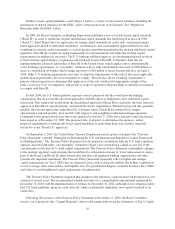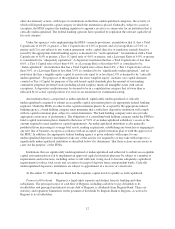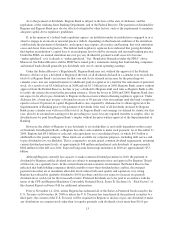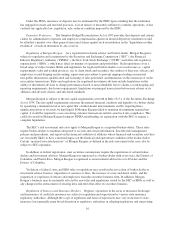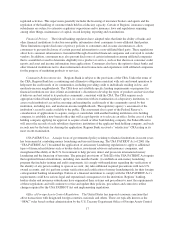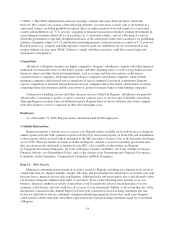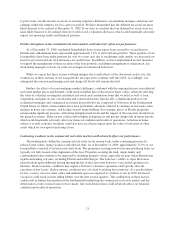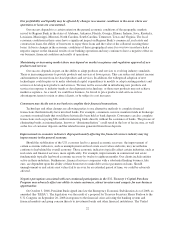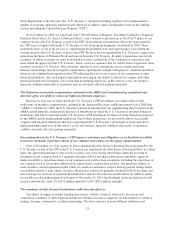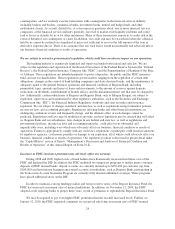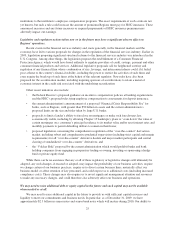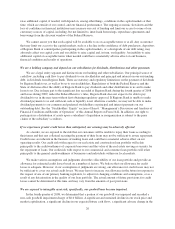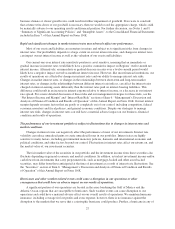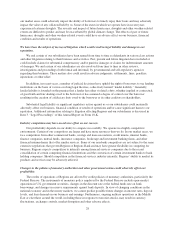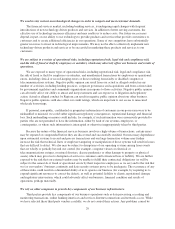Regions Bank 2009 Annual Report Download - page 34
Download and view the complete annual report
Please find page 34 of the 2009 Regions Bank annual report below. You can navigate through the pages in the report by either clicking on the pages listed below, or by using the keyword search tool below to find specific information within the annual report.Any reduction in our credit rating could increase the cost of our funding from the capital markets and/or
place limitations on business activities related to credit support provided to customers.
The major rating agencies regularly evaluate us and their ratings of our long-term debt based on a number of
factors, including our financial strength and conditions affecting the financial services industry generally. During
2009, all of the major ratings agencies downgraded Regions and Regions Bank’s credit ratings. In addition, many
of our ratings remain on negative watch or negative outlook. Negative outlook, negative watch and other similar
terms mean that a future downgrade is possible. The ratings assigned to Regions and Regions Bank remain
subject to change at any time, and it is possible that any ratings agency will take action to downgrade Regions,
Regions Bank or both in the future.
In general, ratings agencies base their ratings on many quantitative and qualitative factors, including capital
adequacy, liquidity, asset quality, business mix and level and quality of earnings, and we may not be able to
maintain our current credit ratings. In addition, ratings agencies have themselves been subject to scrutiny arising
from the financial crisis such that the rating agencies may make or may be required to make substantial changes
to their ratings policies and practices. Such changes may, among other things, adversely affect the ratings of our
securities or other securities in which we have an economic interest. Any decrease, or potential decrease, in credit
ratings could impact our access to the capital markets or short-term funding and/or increase our financing costs,
and thereby adversely affect Regions’ liquidity and financial condition. Where Regions Bank is providing forms
of credit support such as letters of credit, standby lending arrangements or other forms of credit support, a decline
in short-term credit ratings may require that customers of Regions Bank seek replacement credit support from a
higher rated institution. We cannot predict whether customer relationships or opportunities for future
relationships could be adversely affected by customers who choose to do business with a higher rated institution.
Currently, Regions’ Senior ratings from Standard & Poor’s, Moody’s Investor Services, Fitch Ratings and
DBRS are 2, 1, 3 and 4 notches, respectively, above non-investment grade ratings. A downgrade of Regions to a
non-investment grade rating by one or more of the ratings agencies could significantly affect our ability to
borrow funds and raise additional capital and our cost of capital. The market for non-investment grade securities
is much smaller and less liquid than for investment grade securities. Our counterparties are also sensitive to the
risk of a ratings downgrade and may be less likely to engage in transactions with us, or may only engage in them
at a substantially higher cost, if our ratings were downgraded to below investment grade. The effect of such
downgrades in our derivative positions is discussed in Note 21 “Derivative Financial Instruments and Hedging
Activities” of the Notes to the Consolidated Financial Statements in Item 7. of this Annual Report on Form 10-K.
Our credit ratings are discussed in greater detail under the “Credit Ratings” section of Item 6. “Management’s
Discussion and Analysis of Financial Condition and Results of Operation” of this Annual Report on Form 10-K.
The value of our deferred tax assets could adversely affect our operating results and capital ratios.
As of December 31, 2009, Regions had approximately $950 million in net deferred tax assets essentially all
of which was disallowed when calculating Tier 1 capital. Applicable banking regulations permit us to include
these deferred tax assets, up to a maximum amount, when calculating Regions’ Tier 1 capital to the extent these
assets will be realized based on future projected earnings within one year of the calendar year end. The ability to
realize these deferred tax assets during any year also includes the ability to apply these assets to offset any
taxable income during the two previous years. Unless we anticipate generating sufficient taxable income in the
future, we may be unable to include additional amounts related to our deferred tax assets as part of our Tier 1
capital. The inability to include future increases of deferred tax assets in our Tier 1 capital could significantly
reduce our regulatory capital ratios. Additionally, if the entire amount of our deferred tax assets is disallowed,
any prospective taxable loss will reduce Tier 1 capital without any related income tax benefit.
Additionally, our deferred tax assets are subject to an evaluation of whether it is more likely than not that
they will be realized for financial statement purposes. In making this determination we consider all positive and
negative evidence available including the impact of recent operating results as well as potential carryback of tax
20


